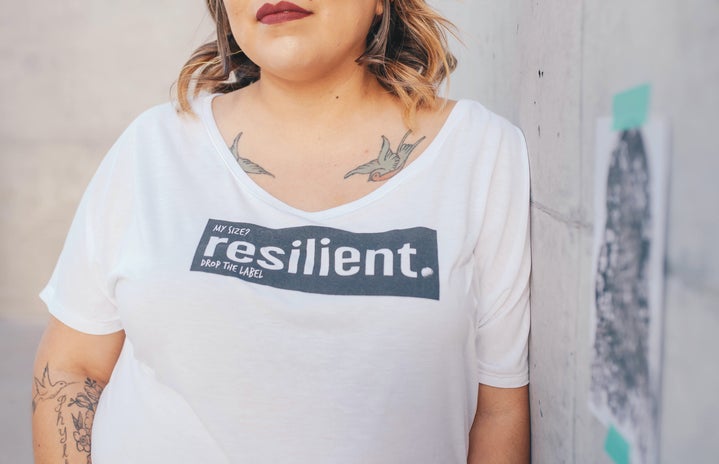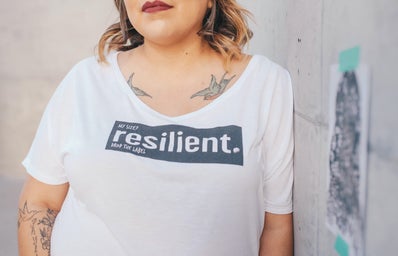The first thing my best friend, Jessica, ever said to me had to do with my knees. “You have big knees,” she said in between bites of her peanut butter sandwich. We were in the school cafeteria on the first day of third grade. I had worn a denim skirt for the occasion.
“Well,” I stumbled, aware of my fellow classmates watching, “you also have big knees.” Jessica paused, peanut butter stuck to the roof of her mouth, and then laughed. My retort had done the trick; she had found a strange sense of respect for me – a moment of true touché, if you will. We eventually became best friends due to similarities beyond our “big knees”: our Italian-Irish families, our affinity for stealing library books, and our talent for cutting snowflakes.
Jessica and I have laughed about our meet-cute many times. But underneath our laughter is always the hint of discomfort: our friendship started on the grounds of exclusion. We had put each other down when we were just nine years old. Where had we learned that behavior? What were we competing for?
But the answer was right in front of us like a pallid mirror. Women had taught us to humiliate each other. We were fighting for the spot of “most girlish” and “most womanly” – a coveted position of beauty, virtue, grace, and mostly, the antithesis of all things masculine.
If not my dance knees, I was berated for my voice. It has always been raspy and lower, so the first insults I received were about how unfeminine it sounds. Girls constantly giggled about my “man voice” and compared it to the boys’ voices in class. Those comments eventually transcended into the idea that I must be boyish, too. People asked me if I played guitar, if I was into skateboarding, if I played video games, and if I liked rock music – the embodiment of the American boy stereotype.
Puberty gave me curves and a sudden interest in Juicy Couture tracksuits. But even then I was still cast as masculine. My girl classmates always assumed I had an “in” with the boys. “Do you know if X likes me? Can you find out who X has a crush on?” The truth was, however, that I did have an “in” with the boys. Not because I sought out boy friendships over girl friendships, and certainly not because of that clichéd “boys are less drama” excuse.
No – I was friends with the guys because it made me feel feminine. I could play streetball with them and throw fake punches in the hallway. I could collect Pokémon cards and listen to their heavy metal music. When they excluded me from more “boyish” activities, I didn’t feel upset about it. I felt relieved that they viewed me as a girl. I didn’t need to convince them.
But everything slowly exhausted me. There’s nothing wrong with identifying as male, but it made me uncomfortable. I felt like a girl, and I wanted to be a girl with girl friends. I was tired of putting on a hyper-feminine performance in front of girls and the pseudo “cool girl” personality in front of guys. I just wanted a group of friends where I could be myself.
Before high school, my father took a new job, and we moved to a much wealthier, much tinier town. I was excited to rebrand myself – I could finally, maybe, have a big group of girlfriends. I wanted to be whatever it meant to be a girl there. My grandmother dressed me in denim jackets and white dresses. I had a new pair of boating shoes and a layered haircut. She told me that this is what Connecticut girls look like.
But I discovered, quickly, that no one has anonymity in a small town. The friend groups had been established long before the students knew how to write their names, and I found myself suddenly falling into the same dual-identities. At one cross country practice, a girl asked me if I was lowering my voice on purpose. Then she told me I was “kind of intimidating.”
A few girls and I had grown close, so we hung out after school one day. It became obvious that they were grooming me for something. They told me they were looking to hang out with someone “different.” They told me that I was really lucky because some hot guy named Graham had a crush on me. I agreed to meet Graham, who asked me five minutes into our “date” if I give good blowjobs. I had just turned fifteen.
Later, I had struck up a lukewarm friendship with two girls from English class. We were walking out from the school together talking, when Daniel held the door open for me. Daniel was a boy from our grade. He recommended me good horror movies to watch and helped me with my math homework. He was someone I could share a secret with.
I grabbed the door from Daniel and said thanks, only to turn around and see the pale faces of my two peers. “I’ve never seen Daniel do anything like that,” one girl said. “He’s just not like that” agreed the other. “He’s my friend,” I told them, and they looked bewildered. It was then that I knew it was over for me: their feelings of confusion had been replaced by jealousy. A few weeks later and the comments started:
“Guys only want to be your friend because you act sexual.”
“Are you gay?”
“You try so hard to be cool.”
“Are you sure you’re not gay?”
“You’d make a good lesbian.”
Luckily, I graduated high school with only minor ego-bruising. But now that I live in New York, and now that I meet people who regularly don’t subscribe to gender norms, it’s easier to see the insecurities that contribute to this “survival of the prettiest” dilemma.
It appears that being a woman is no different than contributing to the idea of womanliness: keeping attractive, sparkly, well-groomed, sweet, high-pitched, shy, elegant, sexy. Those who do not immediately fit the title are scrutinized or put under the magnifying glass. We have gotten better about accepting those who do not subscribe to gender and those who identify differently. We have grown to be more accepting of body image and mental illness. I was personally thrilled to see that the Victoria’s Secret fashion show was canceled for 2019. It was about time that the company revamped their campaign to fit the global demand for more realistic figured.
Our media may not have a concrete image of what a woman is, but it expresses quite clearly what a woman is not, or should not be: women shouldn’t be muscular, women shouldn’t wear too much makeup, women shouldn’t have lots of tattoos, women shouldn’t curse. There seem to be more shouldn’ts than shoulds. And most of these shouldn’ts, unsurprisingly, has to do with appearance in the public space.
If we are going to wear pink Pussyhats and claim “feminist” on our Instagram stories, we need to take a serious step back and consider if we are contributing to the very problem we are fighting. It’s divisive to say we are for women’s rights while simultaneously putting down other women.
I’m hoping we will eventually distinguish manliness and womanliness from the masquerades. It seems that, globally, we are more ready than we’ve ever been to rid ourselves of these disguises and quit starving ourselves of our identities. Whether radical or superficial, there is a difference between authenticity and performance when it comes to ourselves. Let’s redefine these constructs. Let’s quit putting each other down.

